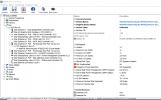I have seen
which explains (between 1:00 and 2:30) that PCI Express Version 3.0 and Maximum Link Width 2x are minimum, and 4x is highly recommended.
Unfortunately, my Toshiba Portégé Z30-C 12Z only has Maximum Link Width 1x.
Do you agree that I should better get myself an Samsung 860 Evo M.2 SATA SSD rather than my currently bought Samsung 970 Evo M.2 NVMe SSD?
Or is there some - not too expensive - way I could upgrade my laptop, so that I could use Maximum Link Width 4x or at least 2x?
Is the RealTek Semiconductor RTS5227 PCI-E Card reader with Maximum Link Width 1x possibly the component responsible for the 1x Maximum Link Width of the PCI Express Root Port?
And could replacing this component make the difference?
Unfortunately, my Toshiba Portégé Z30-C 12Z only has Maximum Link Width 1x.
Do you agree that I should better get myself an Samsung 860 Evo M.2 SATA SSD rather than my currently bought Samsung 970 Evo M.2 NVMe SSD?
Or is there some - not too expensive - way I could upgrade my laptop, so that I could use Maximum Link Width 4x or at least 2x?
Is the RealTek Semiconductor RTS5227 PCI-E Card reader with Maximum Link Width 1x possibly the component responsible for the 1x Maximum Link Width of the PCI Express Root Port?
And could replacing this component make the difference?
Attachments
Last edited:


